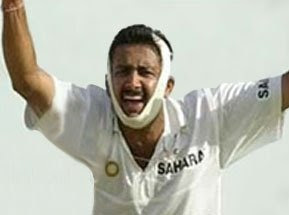 After a rather long spell in hibernation, I have resurfaced to doff my hat to the ever effervescent Anil Kumble. A legend whose commitment to his team has been unquestioned throughout his two-decade cricketing career. Images of a heavily bandaged Kumble in Antigua in 2002 after fracturing a jaw, or that of a scorecard reading 10/74 against his name in Delhi in 1999 remain etched forever in the memories of the Indian cricket fan. “Jumbo”, as he is fondly called has enjoyed a stain-free cricketing career; and for someone who has played international cricket for as long as Kumble has, staying away from controversy is no mean achievement. Even Sachin Tendulkar cannot boast of such an accomplishment (after the infamous ball tampering incident in Port Elizabeth in 2001, or even the customs duty waiver on his Ferrari). In fact, Rahul Dravid once remarked that Anil Kumble is the kind of guy who you would want your sister to marry.
After a rather long spell in hibernation, I have resurfaced to doff my hat to the ever effervescent Anil Kumble. A legend whose commitment to his team has been unquestioned throughout his two-decade cricketing career. Images of a heavily bandaged Kumble in Antigua in 2002 after fracturing a jaw, or that of a scorecard reading 10/74 against his name in Delhi in 1999 remain etched forever in the memories of the Indian cricket fan. “Jumbo”, as he is fondly called has enjoyed a stain-free cricketing career; and for someone who has played international cricket for as long as Kumble has, staying away from controversy is no mean achievement. Even Sachin Tendulkar cannot boast of such an accomplishment (after the infamous ball tampering incident in Port Elizabeth in 2001, or even the customs duty waiver on his Ferrari). In fact, Rahul Dravid once remarked that Anil Kumble is the kind of guy who you would want your sister to marry.Kumble’s participation in the IPL, as well as that of the many golden oldies such as Tendulkar, Ganguly, Dravid, Gichrist, Jayasuriya, Hayden etc. was seen with a lot of skepticism, particularly with respect to the fitness and agility that this form of game demands. But just one week in to the tournament most of them showed that they are up to speed with the younger lot, and by the end of the tournament they had outperformed the youth on all counts by a mile – Hayden being the top run scorer, Kumble being the second-highest wicket taker (at a much superior economy rate than RP Singh, the highest wicket-taker), and Adam Gilchrist effecting the most dismissals in the tournament.
Kumble’s job at the helm of Royal Challengers Bangalore (RCB) after the departure of the much hyped (in my opinion overrated and overpaid) Kevin Pieterson was onerous to say the least. After all who would have given both Deccan Chargers and RCB any odds of making it to the finals? But Jumbo took up the challenge, just like he has done over the past two decades while providing yeoman service to the Indian and cricket team; and just like always, he didn’t disappoint this time either. In fact, he led from front – he emerged as one of IPL’s most lethal bowler and one of shrewdest captains. Bringing himself on to open the bowling against Adam Gilchrist was just one such masterstroke. All-in-all, Kumble emerged as the modern day Cinderella Man.
Those who remember Ron Howard’s depiction of James J. Braddock in the 2005 film Cinderella Man, will probably appreciate the uncanny similarities between the circumstances in the biographies of both these legends. Braddock’s unceremonious expulsion from professional heavyweight boxing coincided with the Great Depression in the 1930s, while Kumble unconvincing retirement from international cricket coincided with the deepest recession since the Great Depression. Braddock fought poverty and persistent injuries to revive a flagging career, while Kumble fought obtuse selectors and age to revive a declining career. Most of all, the people of America in the 1930s, and the people of the sub-continent today were looking for an inspiration to stimulate the otherwise gloomy conditions. Both, Braddock and Kumble provided that impetus to the people – Braddock represented the hopes and aspirations of the American public coping with the Depression, and it is my hope that Kumble’s heroics do the same to the people of the sub-continent.
Braddock’s story might have had a perfect ending with him winning the world heavyweight championship, the unfathomable batting display by the RCB middle order ensured Kumble’s would not. Alas, Kumble ended up as a victim of the biggest limitation of team sports – that individual heroics are often overshadowed by the collective idiocy of a few people.